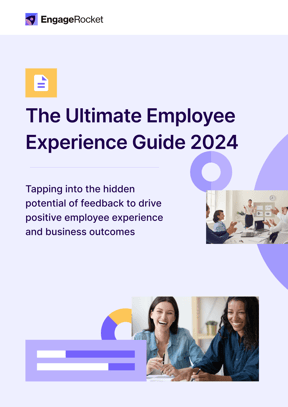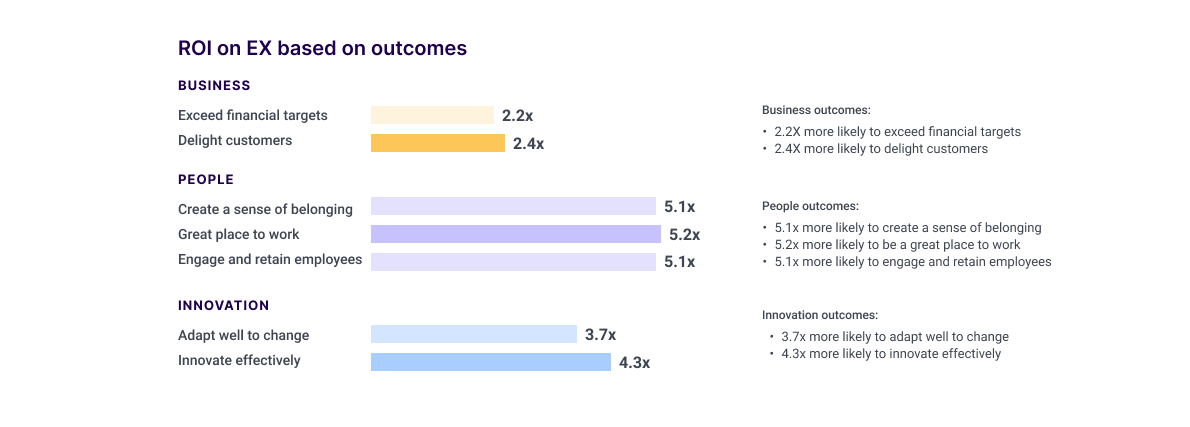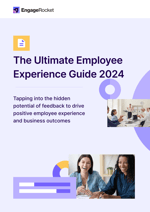

Employee experience (EX) remains pivotal in today's dynamic business environment. As the pace of organizational transformation accelerates and the nuances of remote work become more ingrained, there's an increased focus on crafting human-centric workspaces. Over the years, the role of managers in shaping this experience has come into sharp focus.
In a recent survey we conducted, nearly half of the respondents believe that managers bear the responsibility for driving employee engagement. Meanwhile, 37% view this as a duty of the C-suite. What's surprising is that only 11% associate HR with this critical responsibility.
Organizations that prioritize employee experience, especially through effective managerial leadership, position themselves for an undeniable competitive advantage.
By deploying robust feedback mechanisms, businesses can tune into the immediate needs, aspirations, challenges, and incentives of their workforce. These insights lay the foundation for data-driven strategies, fostering sustained employee engagement.
Employee experience is defined as the cumulative impact of the multiple interactions that an employee encounters over their tenure with an organization, spread across all job-related sites, including the physical office, a WFH environment, commute, work-related travel, and the mind space inhabited during work.
To understand what constitutes employee experience, it is helpful to plot this concept against four contributing dimensions:

Employee Engagement can be defined as a mix of psychological states, attitudes, and behavior toward one’s job and organization. It encompasses the feeling of dedication, energy, and absorption in work (i.e., work engagement), desire to make the best effort at work (i.e., work motivation), emotional attachment, loyalty and dedication towards organization (i.e., commitment), as well as a feeling of belonging and oneness with organization (i.e., identification). In a systematic literature review of research between EE and business performance, it was found that EE supports organizational development and leads to improved business performance. In addition, EE also impacts valued attitudes such as active learning, innovation, knowledge sharing and adaptability.
On the other hand, Employee Experience (EX) is a holistic view of how people interact with and perceive their work. Similar to the way companies approach the Consumer Experience (CX), the end-users motivations, wants and needs are at the core of EX, and the critical objective is to find the intersection between those elements for each organization. By deeply understanding the human aspects of working in the organization, employers can design a tailored experience that demonstrates empathy towards employees, in turn building employee engagement, loyalty and performance. This is based on the belief that ‘your employees are your brand’.
EX takes into account the drivers of engagement all along the employment journey, with engagement being an outcome of EX. By focusing on the physical, cultural, digital, and work dimensions of the organization, a positive EX drives engaged employees.
Four key components constitute engagement:
1. Work engagement
2. Work motivation
3. Work and organizational commitment
4. Convergence with self
As you can see, while there is an overlap between the factors contributing to high employee engagement and a positive employee experience, the two concepts are distinct from each other. EX is vaster, influenced by granular factors like the ambient temperature and lighting conditions of the workplace, which do not impact engagement.
High engagement, on the other hand, is a specific outcome of positive experiences, along with other outcomes such as employee satisfaction and productivity. However, engagement and its relationship with EX needs to be closely studied to thrive in the ongoing war for talent.

It is vital to zoom out and consider engagement not only as a standalone concept but in the context of the holistic employee experience and the end-to-end employment journey. By deeply understanding the human aspects of working in an organization, employers can design tailored experiences that demonstrate empathy, build engagement, drive business outcomes, and eventually intersect the workforce with your corporate brand.
Simply put, tangible benefits and financial rewards alone aren’t enough to engage employees in the new normal. Instead, companies must look at more human and intrinsic drivers that make up EX throughout the employee lifecycle and eventually lead to higher engagement.
Apart from helping employees stay engaged, the nature of EX influences several other parameters of organizational success. Specifically, there are five reasons why companies must evaluate the cumulative experience across the average employee lifecycle and deliver EX tailored for business outcomes.
Research suggests that employee engagement and EX is linked to both team- and individual-level performance. According to Josh Bersin’s Definitive Guide 2021, organizations are 2.2X more likely to exceed financial targets if their HR facilitates positive EX. On similar lines, IBM and Globoforce’s study found that positive EX is linked to higher self-reported work performance and discretionary effort. The link between EX/engagement and productivity/performance could also have to do with the presence of transformational or inspiring leadership in an engaging work environment.
While job satisfaction and employee engagement may be different, they are most definitely correlated. Research by Governors State University found this correlation to be extremely strong for jobs in the public sector, making it vital to invest in EX design that ensures employees are satisfied. In fact, satisfaction with the job (i.e., contentment with basic job traits like pay, commute, and co-workers) is the bedrock for longer-term engagement that staves off attrition. Josh Bersin’s report confirms that when organizations invest in EX, they are 5.1X more likely to create a sense of belonging and retain employees.
Companies can bring about higher levels of well-being by working towards greater engagement. This is because an engaged workforce is less vulnerable to stress and burnout, receiving timely support and guidance from leadership in tough situations. Also, workplaces that value EX and engagement will also strive for work-life balance, avoiding myriad mental and physical health risks. In a recent report post the pandemic, Gallup emphasized that it is vital to invest in employee engagement (given the current global average of 20%) so that it improves overall well-being. As offices reopen, physical well-being measures such as sanitization, safe distancing, and air quality checks must be central to EX design.
Absenteeism and turnover – two primary indicators of workforce disengagement – can be measurably curtailed by reimagining the employee experience. Gallup found that teams in the top quintile of engagement have successfully realized a 41% reduction in absenteeism and a 59% reduction in turnover. In an engaged workplace, not only are employees more motivated to “turn up” and bring their best to work but they are also encouraged by leadership to address burnout to avoid long-term repercussions like absenteeism arising from ill-health. Also, employees will feel a strong sense of purpose and involvement in the company’s objective, preventing turnover.
How your employees feel in the workplace will reflect directly in their attitudes when interacting with customers and the consequent CSAT. This is particularly true for customer-facing roles and industries like retail or contact centres – for example, Cisco found that the quality of agent experience has a significant impact on customer experience at nearly three-quarters (74%) of organizations. Even for mid and back-office roles, positive EX and an engaged workforce will lead to better products and more streamlined processes that have a ripple effect on CX and customer satisfaction. On similar trends, Josh Bersin's latest report shows where companies are leveraging the right EX strategy, employees are 2.4x more likely to delight customers.
For your investments in employee experience to be successful and sustainable in the long term, you need to clearly measure the ROI. Measuring ROI on EX helps to get leadership buy-in on transformative HR programs, identify opportunities and challenge areas in your EX policy, and budget for employee centricity as you grow.
As industry leader Josh Bersin noted Employee Experience excellence directly leads to positive outcomes – across three areas Business, People and Innovation.

The process of calculating the returns accrued from positive EX and greater engagement usually focuses on financial targets, described below. It is important to remember that while this is an important outcome of employee experience excellence, it is not the only one.
Positive employee experiences and an engaged workforce can significantly reduce a company’s operational expenses, thereby improving your bottom line. This includes savings from reduced absenteeism, lower healthcare costs, a reduction in workplace accidents and related penalties, and, most importantly, savings in turnover costs. In addition, your costs of executive hiring will also decrease as a more engaged workforce, and greater commitment towards the company paves the way for internal hiring, upskilling, and a more efficient succession plan.
In addition to helping organizations save, investments in EX can also help you earn. These can be factored in as additions to your top-line revenues – as a result of better talent (hired via referrals from highly engaged employees), better products (built by employees who understand and are invested in the company’s vision), better services (provided by employees that are happier, and enjoy a state of mental and physical wellbeing), and a better reputation (promulgated by employees that act as your corporate and cultural advocates). Investment in EX can unlock sales profitability (driven by motivated employees who contribute to the company’s objectives) in the short term and a significant rise in equity value in the long term.
The third component of your returns from EX is the gains obtained from greater ease in conducting daily business operations. For example, as engaged employees recommend their talented peers, you’ll find your recruiting pipeline becoming more efficient and cost-effective. Similarly, problem-solving happens much faster in a highly engaged work environment. Employees are more likely to adhere to leadership decisions, removing operational bottlenecks. Product development cycles also accelerate, helping to get a first-to-market advantage. All of these will factor into your ROI as gains from ease of doing business.
To calculate ROI, therefore, organizations must take stock of the as-is state of performance even as they come up with a new EX strategy. As the change program is implemented in stages, the metrics used to measure as-is performance are re-examined. This reveals the incremental % increase over time and allows you to dynamically adapt your EX strategy to invest in areas that are most value-generating.
As the future of work evolves and a global competition for talent intensifies, prioritizing the employee experience is essential. Your EX strategy and investments this year could shape financial outcomes for several upcoming quarters. From upskilling employees in relevant areas to managing attrition risk, from acknowledging top performers to thoughtfully crafting a benefits package, the coming year will be a period of comprehensive transformation. This demands a structured three-pronged approach.
The first step is to align your employee experience strategy (milestones, interventions, goals, and KPIs) with the larger business strategy in place for the same upcoming period. This will help to measure and report clear outcomes throughout EX implementation so that the expected and predictable ROI is achieved. There are six best practices companies must keep in mind at this stage:
Download your own PDF copy :
✔️ Learn more on how to calculate the ROI on employee experience
✔️ The distinction between EX and engagement
At this stage, organizations should aim to build the bedrock of the EX program through sophisticated analytics that can help extract insights into employee experience, engagement, and the potential effect on business.

Daniel Chia
Head of Human Resources


Kuan-Thye, SEAN
Managing Director Employee Experience Design & Implementation

Employee experience is not a static entity, and neither are the needs or expectations of your organization. That’s why an ecosystem of multiple channels is necessary to listen to the sentiment of the workforce – also known as the Voice of the Employee (VoE). Continuous listening programs that pay attention to VoE can reveal insights into true intent and experience that debunk popular assumptions.
For example, EngageRocket’s benchmark found that a dip in the number of employees at risk of burnout didn’t necessarily mean that they were able to avoid burnout. Between 2020 and 2021, the section of the workforce able to avoid burnout decreased by 17%, and those unable to avoid burnout also decreased by 4 percentage points. It is the neutral or coping population that shot up. Continuous listening reveals the true picture of what employees are going through on-ground, avoiding misleading stereotypes, assumptions, and broad-stroke analytical fallacies.
There are five best practices companies must keep in mind at this stage:
Leverage multiple channels - Multiple channels and a diverse set of tools will get you insights into the many aspects of employee experience. It factors in all forms of VoE, and by combining a variety of data sources, you can root out false positives and false negatives. It is advisable to use organisation-wide surveys, lifecycle surveys, pulse surveys, multi-rater feedback and open-ended comments.


Org-wide Surveys
Involve the entire population, to gain breadth and depth of info across the organisation.
Lifecycle Surveys
Specific individuals are invited to participate based on their stage in their employee lifecycle, eg onboarding or exit surveys. These are “always on”.
Pulse Surveys
Extended to a sample or the whole population. Useful for tracking trends, diving into detail on specific topics or employee groups. Eg. employee net promoter score, 10-20 question “dipstick” surveys, or longer topical surveys on topics like total rewards, mental health, diversity & inclusion, etc.
Multi-rater Feedback / 360° Reviews
Either include peer reviews, 180° or 360° feedback focusing on manager behaviours, competencies or values. These are usually reserved for developmental purposes, but when used carefully, may be applied as input for performance appraisals.
Comments / Sentiment
These include the analysis of open-ended comments in surveys, as well as the ability to respond to these comments in a psychologically safe way, eg. via an anonymous 2-way chat. This provides qualitative input to supplement the quantitative data collected via other methods.
Develop two-way communication - The continuous listening mechanism must include an acknowledgement of the fact that the VoE has been heard. You can achieve this by designing communications based on the input from end-users. The feedback can help shape follow-up actions such as further questions, and a brief snapshot of the insights gathered, creating a closed feedback loop. A closed-loop will ensure that the conversation is genuine and authentic (instead of being top-down), and positively contributes to the bonds of trust.
Get employee buy-in for continuous listening - A continuous listening strategy, as opposed to one-off programmes, requires active buy-in and participation from the workforce. Ineffective surveys can exacerbate disengagement instead of detecting its root cause. That’s why it is important to first communicate the programme to employees, set up continuous listening Champions if needed, and demonstrate the benefits of active participation. For example, frequent check-ins pioneered at Netflix by Patty McCord helped to both improve performance as well as reduce stress and anxiety.
Make it cross-functional - Continuous listening cannot be just a one-off checklist exercise, siloed to a single department, team, or business unit. That’s why companies must configure a centralised programme supported by data unification between departments to gather meaningful insights for specific employee segments and specific employment lifecycle milestones across the organisation. Different functions have different needs, different OKRs, and it's important to examine differences across various functions to identify opportunities for improvement.
Weave continuous listening into your culture - In the long term, listening to the VoE has to be so embedded in the company culture that it takes place seamlessly, through both formal and informal efforts, and can capture the micro-experiences of an employee’s workday. This requires training managers on the tenets of EX and employee centricity and active participation from senior leadership.
The final step of your three-pronged roadmap to becoming an EX-first company involves the meaningful utilization of data to solve real employee problems. In addition, stakeholders across the organization, from HR and management to team leaders and learning professionals, must know their role in EX and the outcomes they are striving for.
They should be focused on garnering regular feedback and acting on the same in alignment with the KPIs and targets established in the first step.
There are four best practices companies must keep in mind at this stage:
Download your own PDF copy :
✔️ Learn more on how to calculate the ROI on employee experience
✔️ The distinction between EX and engagement
The insights from continuous listening and VoE programs will be collected in a centralized manner, ready for dissemination and use across the organization. This means that key stakeholders must be trained in data interpretation to garner the most meaningful and relevant insights from the centralized repository. A smartly designed dashboard with role-based access can also help, as it ensures that the right data reaches the appropriate stakeholder and that the insights are easy to read without any statistical knowledge.
An environment of psychological safety is essential if employees are to express themselves and provide authentic feedback. Worryingly, our research found that more than a third of employees said that they do not discuss work-related problems with their managers. Trends like these can work against you when building an EX-first company, denying employees the psychological safety they need to express the genuine VoE. That’s why managers and leaders have to be trained on this aspect of work culture, particularly in the context of remote and hybrid work.
A clear framework of data-based interventions is required to guide the organization consistently and holistically toward a more positive EX. Managers should be able to read data, understand the intervention required using the framework, and act on time. The impact of the intervention should also be measured, as the accumulated impacts over time will give you the ROI from EX investments.
The three prongs – beginning with Strategy and Analytics, Consolidating by Continuous Listening to the VoE and thriving through Action and Ownership – will assist organizations as they place employee experiences in the front and center of their people strategy, business strategy, and eventually, the super-long-term corporate vision.
Selecting the right employee experience tool is vital for robust workforce engagement. It's essential to evaluate key factors when choosing an employee engagement platform.
When selecting a tool to boost employee engagement, it's crucial to ensure it caters to the diverse needs of all stakeholders involved:
HR Teams: are at the frontline of implementing these tools. For them, reliability is key. They need a system that doesn't falter, is adaptable to the changing needs of the organization, and is backed by prompt support. Additionally, a rigorous quality control mechanism is essential to ensure that the tool remains effective over time.
C-suite Leaders: The top management often looks at the bigger picture. For them, a tool isn't just about gathering feedback—it's about deriving actionable insights that can drive business growth. They prefer a tool that can offer tailored recommendations directly linked to critical business metrics and provides trend analysis to anticipate future needs or challenges.
Managers: Often acting as the bridge between the workforce and the leadership, managers need tools that are straightforward to use. Essential to their workflow is the ability for the solution to integrate seamlessly with platforms they're already familiar with, such as Teams, Slack, and other collaboration tools. They require access to essential data that can help them understand their team's sentiment and dynamics. Beyond just raw data, they benefit from conversation guides that can help navigate sensitive topics. Actionable suggestions provided by the tool can be invaluable for managers, enabling them to take immediate steps to enhance engagement within their teams.
Employees: Their trust and buy-in are essential for the success of any tool. As such, the tool needs to guarantee confidentiality, ensuring their feedback or data isn't misused. Furthermore, an intuitive and user-friendly interface will make it easier for them to interact with the system, ensuring higher participation rates.
Given the varied needs of each group, it's imperative to engage in a comprehensive consultation process. Before settling on any solution, conduct thorough discussions with each stakeholder group to gather their specific requirements. Only by understanding and addressing everyone's needs can you choose a tool that truly drives employee engagement across the board.
In a great partnership, transparency involves a commitment to open communication, developing trust, and setting clear expectations. When you prioritize transparency while choosing an employee engagement tool, you can collaborate effectively with the provider. An open and honest dialogue ensures that your organization and the employee engagement tool provider are on the same page. This can lead to more productive and tailored engagement strategies.
Customizability gives power to HR managers to tweak the employee engagement platform as per their unique needs, preferences, and goals. With customizable dashboards, you can design them as per your organization's branding, workflow, and goals. You'll notice that it improves usability and relevance.
Plus, your teams can see the specific insights and data points that matter most to them. This customized setup helps you focus on particular actions because you have the right data.
These experts have an intimate understanding of the tool's intricacies. So, if you ever run into problems or questions about how to use the tool, these experts can help you quickly. They can fix issues, give you advice, and help make your engagement efforts better. It's also crucial to check the Service Level Agreement (SLA) with the provider. Their timely support can reduce downtime and amplify the advantages you reap from the tool.
Your chosen employee engagement tool should excel in project management and responsiveness. A tool with effective project-tracking features will let your teams stay organized. Whether you have to change survey questions or solve other issues, a responsive team ensures that your employee engagement efforts stay on track and meet your goals. Additionally, it's crucial to confirm that the provider employs people science specialists who can provide expert advice, guaranteeing that your strategies are based on solid theories and informed insights.

 .
. 
Copyright © 2025 EngageRocket Pte Ltd. All rights reserved unless otherwise stated.